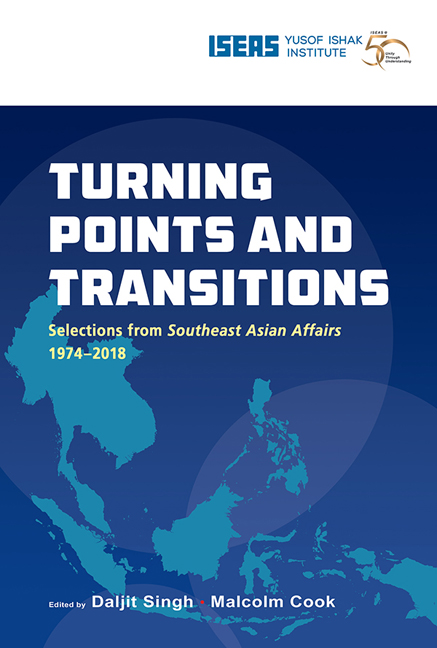Book contents
- Frontmatter
- Contents
- Message from the Director
- Foreword
- Foreword
- Introduction
- THE REGION
- The Diplomatic Emergence of China and Its Implications for Southeast Asia (1975*)
- Stability and Security in the Region after ANZUK (1975)
- The Question of the “Overseas Chinese” (1976)
- Southeast Asia 1976: The Handling of Contradictions (1977)
- The “Fukuda Doctrine” and Its Implications for Southeast Asia (1978)
- Expanding Horizons in Southeast Asia? (1994)
- AFTA in the Light of New Economic Developments (1995)
- The ASEAN Economic Miracle Unravels (1999)
- Southeast Asia in 1999: A False Dawn? (2000)
- East Timor's Future: Southeast Asian or South Pacific? (2001)
- Southeast Asia in 2002: From Bali to Iraq — Co-operating for Security (2003)
- The Year in ASEAN: The Charter, Trade Agreements, and the Global Economic Crisis (2010)
- Seeking Stability in Turbulent Times: Southeast Asia's New Normal? (2015)
- China's Two Silk Roads Initiative: What It Means for Southeast Asia (2015)
- China's International Strategy and Its Implications for Southeast Asia (2016)
- BRUNEI
- CAMBODIA
- INDONESIA
- LAOS
- MALAYSIA
- MYANMAR
- THE PHILIPPINES
- SINGAPORE
- THAILAND
- VIETNAM
The Year in ASEAN: The Charter, Trade Agreements, and the Global Economic Crisis (2010)
from THE REGION
Published online by Cambridge University Press: 29 May 2019
- Frontmatter
- Contents
- Message from the Director
- Foreword
- Foreword
- Introduction
- THE REGION
- The Diplomatic Emergence of China and Its Implications for Southeast Asia (1975*)
- Stability and Security in the Region after ANZUK (1975)
- The Question of the “Overseas Chinese” (1976)
- Southeast Asia 1976: The Handling of Contradictions (1977)
- The “Fukuda Doctrine” and Its Implications for Southeast Asia (1978)
- Expanding Horizons in Southeast Asia? (1994)
- AFTA in the Light of New Economic Developments (1995)
- The ASEAN Economic Miracle Unravels (1999)
- Southeast Asia in 1999: A False Dawn? (2000)
- East Timor's Future: Southeast Asian or South Pacific? (2001)
- Southeast Asia in 2002: From Bali to Iraq — Co-operating for Security (2003)
- The Year in ASEAN: The Charter, Trade Agreements, and the Global Economic Crisis (2010)
- Seeking Stability in Turbulent Times: Southeast Asia's New Normal? (2015)
- China's Two Silk Roads Initiative: What It Means for Southeast Asia (2015)
- China's International Strategy and Its Implications for Southeast Asia (2016)
- BRUNEI
- CAMBODIA
- INDONESIA
- LAOS
- MALAYSIA
- MYANMAR
- THE PHILIPPINES
- SINGAPORE
- THAILAND
- VIETNAM
Summary
In the past year, the mass media have highlighted three developments in Southeast Asia, which thus became the subjects of public attention. One was the start of the implementation of the new Charter of the Association of Southeast Asian Nations (ASEAN), particularly the establishment of the ASEAN Inter-governmental Commission on Human Rights (AICHR). Another was the scheduled elimination on 1 January 2010 of tariffs on most goods traded among China and the six older, and more advanced and heavily trading, ASEAN members — Brunei Darussalam, Indonesia, Malaysia, the Philippines, Singapore, and Thailand (the other ASEAN members are Cambodia, Laos, Myanmar, and Vietnam). The third was the response of Southeast Asian countries to the regional impact of the global economic crisis.
The media spotlight on these developments has led the public to expect some dramatic, overnight changes in the region because of them. As an academic, I have sought to dampen such expectations, called for caution, and urged the media and the public to refrain from rash predictions and speculation. As the Americans say, “the jury is still out” on these three questions.
The ASEAN Charter
The drafting of the ASEAN Charter by a task force of senior ASEAN officials, its signing by the ASEAN leaders in November 2007, and its entry into force in December 2008 were significant for six reasons. For the first time, after forty years of existence, ASEAN has adopted a charter for itself, comprehensively placing it more firmly on a rules-based path.
If one looks closely at the Charter's contents, this is more than a matter of form. For the first time, the ASEAN countries have committed themselves in a formal document to norms having to do with the internal behaviour of states. As first enshrined in the 1976 Treaty of Amity and Cooperation in Southeast Asia, norms for inter-state conduct had guided ASEAN and other countries related to it — the peaceful settlement of disputes, the rejection of the threat or use of force, and non-interference in the internal affairs of nations. This is important in itself, but the Charter goes beyond that. In it, the ASEAN countries have declared their aspiration for such goals as democracy, human rights and fundamental freedoms, the rule of law, good governance, constitutional government, and social justice.
- Type
- Chapter
- Information
- Turning Points and TransitionsSelections from Southeast Asian Affairs 1974-2018, pp. 126 - 132Publisher: ISEAS–Yusof Ishak InstitutePrint publication year: 2018

